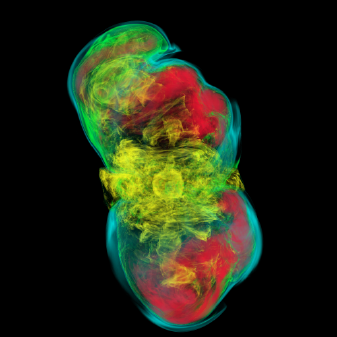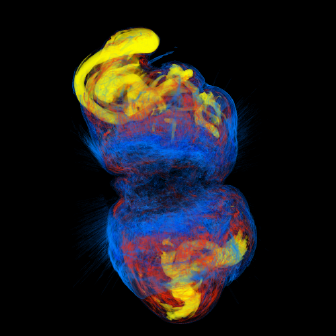Philipp Mösta, Sherwood Richers, Christian D. Ott,
Roland Haas, Anthony L. Piro, Kristen Boydstun, Ernazar Abdikamalov, Christian Reisswig, and Erik Schnetter
ApJ, 785, L29 , arXiv:1403.1230
 |
 |
Abstract
| We present results of new three-dimensional (3D) general-relativistic magnetohydrodynamic simulations of rapidly rotating strongly magnetized core collapse. These simulations are the first of their kind and include a microphysical finite-temperature equation of state and a leakage scheme that captures the overall energetics and lepton number exchange due to postbounce neutrino emission. Our results show that the 3D dynamics of magnetorotational core-collapse supernovae are fundamentally different from what was anticipated on the basis of previous simulations in axisymmetry (2D). A strong bipolar jet that develops in a simulation constrained to 2D is crippled by a spiral instability and fizzles in full 3D. While multiple (magneto-)hydrodynamic instabilities may be present, our analysis suggests that the jet is disrupted by an m = 1 kink instability of the extremely strong toroidal field near the protoneutron star. Instead of an axially symmetric jet, a completely new, previously unreported flow structure develops. Highly magnetized spiral plasma funnels expelled from the core push out the shock in polar regions, creating wide secularly expanding polar lobes. No runaway explosion obtains by the end of the full 3D simulation at ∼185 ms after bounce. At this time, the lobes have reached maximum radii of ∼900km. |
Simulation Source Code
The simulations were carried out with the Zelmani core collapse simulation package, which is based on the open-source Einstein Toolkit, which, in turn, uses the Cactus Computational Toolkit and the Carpet adaptive mesh refinement driver. While not all components of Zelmani are open source yet, we can already provide as open source the leakage/heating module used in this study, ZelmaniLeak. Other components of the code that have modifications that are not yet publicly available as part of the Einstein Toolkit are provided below as well. These should all build smoothly in the latest regular Einstein Toolkit build.
Please contact Philipp Moesta (pmoesta # tapir.caltech.edu) should you have any questions.
| Download CoreCollapseControl_201403.tar_.gz |
| Download Dissipation_201403.tar_.gz |
| Download GRHydro_201403.tar_.gz |
| Download GRHydro_InitData_201403.tar_.gz |
| Download Perturb_201403.tar_.gz |
| Download ZelmaniLeak_201403.tar_.gz |
| Download ZelmaniShockTracker2_201403.tar_.gz |
The parameters used for the electron fraction parameterization used in the collapse phase are as follows:
# ye of rho parameters ZelmaniLeak::yeofrho_rho1 = 1.0e7 ZelmaniLeak::yeofrho_rho2 = 1.0e13 ZelmaniLeak::yeofrho_ye1 = 0.5e0 ZelmaniLeak::yeofrho_ye2 = 0.29e0 ZelmaniLeak::yeofrho_yec = 0.035e0 ZelmaniLeak::yeofrho_do_high_correction = yes ZelmaniLeak::yeofrho_high_correction_ye = 0.2717e0 ZelmaniLeak::yeofrho_high_correction_rho = 2.55e14
Computational Grid Structure
The grid structure of the simulations initially consists of four levels of nested adaptive mesh-refinement (AMR) boxes. During collapse we add 5 more AMR boxes as the central density of the inner core increases. The grid structure at core bounce consists of 9 levels of AMR boxes with half extends of [5674.0 km, 3026.1km, 2435.1, 1560.3, 1283.7, 212.8, 144.8, 59.1, 17.7 km]. The coarsest resolution is h = 94.6 km and refined meshes differ in resolution by factors of 2. We use adaptive shock tracking to ensure that the shocked region is always covered by the AMR box with resolution h = 1.48 km.
The parameters used for adding additional AMR boxed during the collapse phase of the simulations are:
corecollapsecontrol::rho_max_list[0] = 8.0e10 corecollapsecontrol::rho_max_list[1] = 3.2e11 corecollapsecontrol::rho_max_list[2] = 1.28e12 corecollapsecontrol::rho_max_list[3] = 5.12e12 corecollapsecontrol::rho_max_list[4] = 2.048e13
